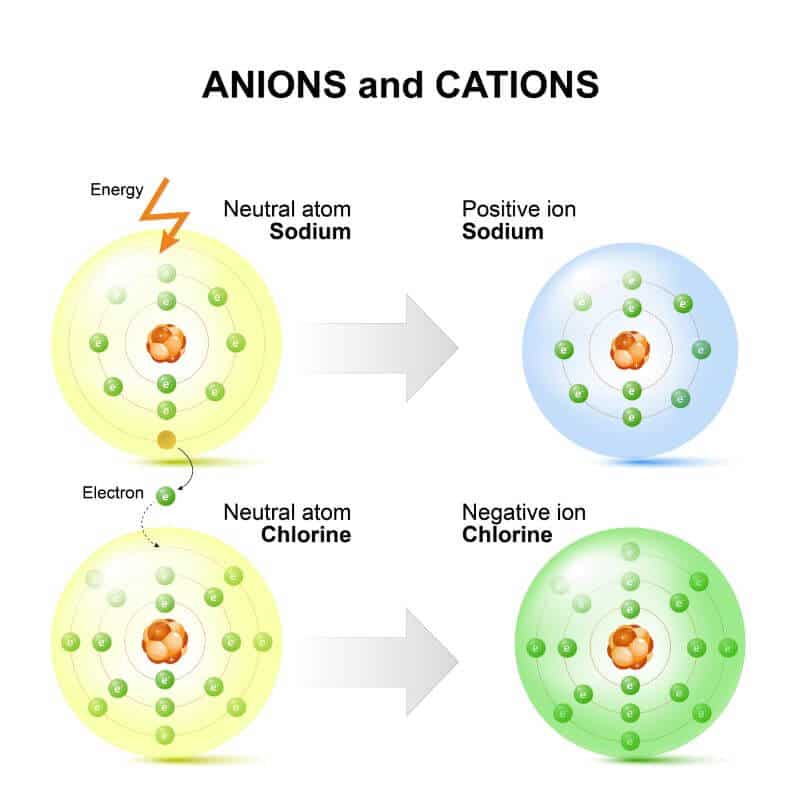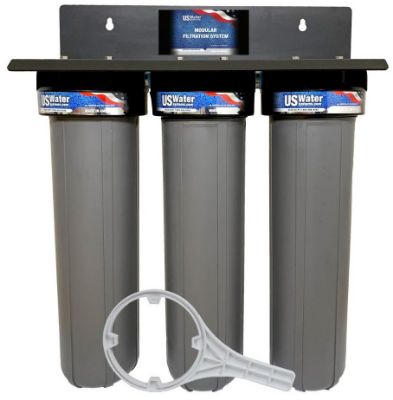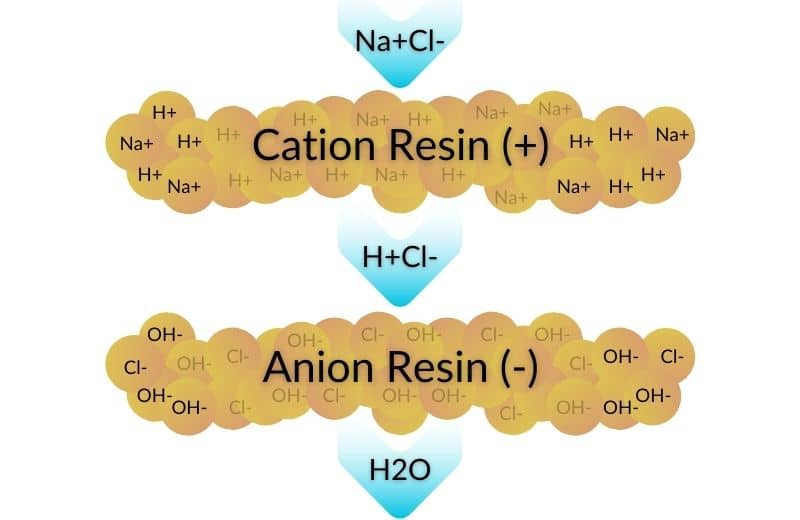There are many water treatment options available today, most of which are geared at improving water quality and making it more appealing to drink. If you’re interested in at-home filtration or purification solutions for your tap water, you may have heard of deionized water.
In this guide, I’ll be answering all the questions you might have about deionized water, including what it is, whether it’s safe to drink, what it’s used for, and whether it’s good for you.
Table of Contents
🤔 What is Deionized Water Exactly?
What is deionized water, in simple terms? Typically, deionized water is a type of purified water that has had all of its ions removed, resulting in a liquid that’s completely free of charge. Normal tap water is full of ions, which come from soil, pipes, and other sources. The only way to remove this charge is by deionizing water.
Deionized water is free of cations (positively charged mineral ions) and anions (negatively charged mineral ions). Some examples of cations are calcium and magnesium, sodium and iron, while sulfates, carbonates and nitrates are all examples of anions.
When tap water is deionized, it takes on a similar quality to distilled water – but it’s important not to get the two confused. The deionization process is much faster, but it’s not as effective as distillation, which can produce highly purified water by removing almost 100% of tap water impurities.

🔎 How Do You Make Deionized Water?
Water can be deionized at home using an DI filtration system. There are several methods of deionization, but usually, the process will involve running water through an electrically charged resin bed. The resin beads will grab onto the salts responsible for water’s charge, allowing only deionized water to pass through.
The charged resins in deionizing water systems consist of thousands of tiny plastic beads. These beads are made from organic polymer chains that have a fixed charge – either positive or negative. The cation resin holds the positively charged beads and the anion resin holds the negatively charged beads. Each resin bed attracts minerals and salts of the opposite charge – so the cation resin attracts anion minerals, and the anion resin attracts cation minerals.
Eventually, the resin bed will be packed with so many ions that it’ll no longer work effectively, and the system has to be regenerated – flushing the resin bed to remove the collected ions – to allow for effective long-term performance.

📝 Methods of Water Deionization
The three most common methods of water deionization are co- and counter-current deionization, and mixed-bed deionization.
Co-current Deionization
Co-current deionization involves the co-current flowing of the regeneration chemicals and water input through the ion exchange column from the top to the bottom. So, in this case, both the water and the regeneration chemicals flow in the same direction.
Counter-current Deionization
Counter-current deionization, on the other hand, sees water and regeneration chemicals flowing in opposite directions. While water flows into the ion exchange column from the top of the system, the regeneration chemicals flow in from the bottom. This process tends to require less time to produce deionized water than the co-current process. As a result, fewer regenerants are required, helping to keep down overall costs.
Mixed-bed Deionization
A mixed-bed deionization machine uses a combination of 50% anion and 50% cation resin, which form a single column for ion exchange. This process produces the best high-purity water of all three methods, but it tends to require a more advanced regenerating process, which makes it the most costly.

🧐 What is DI Water Used For?
The traditional use of deionized water is in medical applications. It can be used alongside disinfectants to clean surgical instruments and sterilize surfaces, reducing the risk of patient infection.
Additionally, deionized water is used in cosmetic products that use water, such as soaps, lotions, toothpastes and lipsticks. It’s important that water used in these products is pure, to prevent it from contaminating the product or altering its chemical composition.
Another use of DI water in a factory environment is for cooling systems. It can be used both for lubricating and cooling systems that could overheat, helping to maintain safe or appropriate temperatures.
At home, deionized water is used in steam irons, fish tanks, humidifiers, and car radiators. It can also be used for cleaning and in homemade air fresheners or perfumes.
✅ Advantages of Deionized Water
Can be Helpful For Short-Term Detoxification
Though research into this is limited, some detox diet websites suggest that DI water might have detoxification benefits when this water is used on a short-term basis. It’s best to speak to a health expert before you consider doing a deionized water detox, as it’s likely that they can help you to find a more suitable solution based on your intentions.
Useful in Medical & Manufacturing Settings
This type of water is incredibly useful for manufacturers in industrial processes, as it prevents the build-up of minerals and salts on equipment, and can be used safely in water-based products. DI water is also commonly used by pharmaceutical industries in the production of medicines, and in hospital environments for sterilizing equipment. Thanks to its lack of mineral content, this type of water doesn’t leave behind a residue and isn’t corrosive.
Quick to Produce
Demineralized water is much quicker to make in an deionizer than, say, producing distilled water in a distiller. Typically, it takes just minutes to run electrically charged water through a deionizing machine, making it a very fast and efficient process.
⚠️ Risks Associated With Deionized Water
Though it might not seem dangerous, drinking deionized water exclusively can have some harmful health effects that are worth being aware of. Generally, it’s advised to use this water for non-drinking purposes, to avoid risks including the following:
Can Accumulate Toxic Metals
If you drink deionized water from your faucet, you’re at risk of the water being contaminated by toxic metals. That’s because high-purity deionized water tends to have a lower alkalinity, which means it’s “hungrier” – it’ll grab onto whatever particulates it comes into contact with, including the metal elements in your plumbing.
Our normal drinking water contains calcium and magnesium, which increases its alkalinity and helps to prevent toxic metals from accumulating. Purified water, however, is less stable because it no longer contains these minerals.
Can Absorb The Body’s Ions
To continue the above point, drinking water that lacks ions is “hungrier” and less stable – so if it gets the chance to absorb ions, it will do so. When you drink deionized water, the water may absorb any ions it comes across once inside your body. As a result, it can decrease your body’s supply of important vitamins, such as calcium and magnesium.
Additionally, DI water is high purity, meaning its mineral content is virtually non-existent. While we get the majority of our mineral intake from our diet, mineral water may still contribute to our daily needs. As a result, if you choose to exclusively drink deionized water, you may not be consuming quite as many minerals as if you were drinking mineral-rich tap water.
Tastes Unpleasant
Deionized water doesn’t contain any of the stuff that makes our water taste nice, which can often leave it tasting a little flat. The problem here is that you’re less likely to drink deionized water if you don’t enjoy the taste. This puts you at risk of dehydration, or you might even end up drinking something unhealthy instead. A second problem with deionized water is that it doesn’t tend to quench your thirst, again making you more likely to be dehydrated if you chose to only drink this type of demineralized water.
❔ Frequently Asked Questions
Is Deionized Water Safe to Drink?
DI water is safe to drink on one-off occasions, but it’s wise not to drink this water on a regular basis. While this high-purity water contains no impurities that might harm your health, it’s more susceptible to picking up the bad stuff, such as toxic metals.
The World Health Organization recently released a report that outlines the dangers of drinking high-purity DI water, which discusses the potential impact of reducing your calcium and magnesium intake and the effect that demineralized water might have on metabolism, homeostasis and other bodily functions. While this report is based on emerging evidence, and research is limited, it’s still worth keeping the information presented in mind.
Is Distilled and Deionized Water the Same Thing?
Distilled water and deionized water are often confused as the same thing, but they’re actually relatively different. Distilled water has been purified by the process of distillation, which removes all dissolved minerals, contaminants and impurities from the water.
To remove the most contaminants and greatly improve DI water quality, you’d have to use a DI filter alongside another system, such as a reverse osmosis system (reverse osmosis is one of the most effective water systems for filtering out contaminants that you can find). A distiller, on the other hand, can do the job of RO systems and ionizer systems in one: it can remove water’s contaminants and make it safe to drink as well as removing its charge.
To find out more about the differences between distilled water and pure water, check out my Purified vs Distilled Water guide.
Is Deionized Water Good for You?
It depends on what you’re looking for, but for the most part, I’d say no. DI water has only had its ions removed. That means that contaminants like chemicals and volatile organic compounds will remain in your water. Distilled water or reverse osmosis water is often a better choice if you’re looking to drink high-purity water that’s free of contaminants.
Is Deionized Water Pure Water?
Yes, DI is considered pure water because it doesn’t have a charge. It’s usually considered pure enough to be used in manufacturing processes and in medical situations, but water produced by distillation may be preferred in some instances. Additionally, because DI water might still contain certain impurities like bacteria, it’s definitely not as pure as it has the potential to be.
Can Bacteria Grow in Deionized Water?
Yes, there’s nothing stopping bacteria from growing in DI water. The ionizing process can’t remove uncharged organic molecules like pathogens, so if your DI water is contaminated with the likes of bacteria, it’s wise to run it through a distilled water machine or a UV purification lamp to remove any pathogens and make your water safe to drink.
If you want to stop bacteria from growing in DI water, make sure to store it in a sealed container, away from sunlight and in a cool location.
Does Boiling Water Make it Deionized?
No. The process of boiling water will simply cause some of the water to evaporate, so you’ll be left with a smaller amount of water with the same amount of minerals and salts as you started with.
There is no way to produce DI water using a DIY technique. The closest you could get is to set up your own at-home distillation process, placing a small pot in the middle of a large pot and boiling water in the large pot, allowing it to evaporate and condense, drip down the lid of the large pot, and collect in the smaller pot. This process takes a really long time, so I would recommend investing in a deionizing machine if you need regular access to DI water.
What Can I Use Instead of Deionized Water?
This depends on what you’re looking for. If you want high-purity, healthy water that you can drink, reverse osmosis water is best. RO water contains no impurities and is of great quality. One of the biggest benefits of a reverse osmosis filtered water system is that you can often purchase a remineralization filter to add minerals like magnesium and calcium back into your water, so you can enjoy fully filtered water that tastes great.
A cheaper alternative to reverse osmosis, if you’re just looking for contaminant removal, is activated carbon filtration. However, an activated carbon filter can’t usually remove minerals and salts – it’s most effective for chlorine and lead removal – so that may be an issue if you specifically want to remove your water’s charge or make your water as clean as possible.
If you just need deionized water for uses like filling your steam iron or performing maintenance on your car, you might opt for distilled water instead. Distilled water is impurity-free, so it won’t leave deposits in your appliances or equipment. Keep in mind, however, that DI water tends to be cheaper than distilled water because it’s quicker to make.
